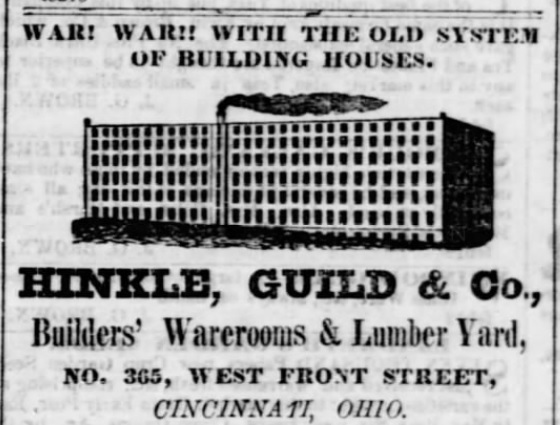History of Hinkle & Company (1833-1870)
Seth Hinshaw, 10/6/2019
Philip Hinkle (1811-1880) opened a contracting business in Cincinnati in 1833. His greatest contribution was to an early form of mail-order house then called the "knock-down" house in which he would build a house, then partially disassemble it, package the materials, and ship the house elsewhere (often to other states) to be built.
Born in Pennsylvania, Hinkle moved to New Orleans in 1831 and then to Cincinnati in 1832. He joined the contracting firm of Howe & Filson upon his arrival but left the firm in early 1833 to start his own contracting business. A neighbor named Evan Gaither entered into partnership with Hinkle in 1834, continuing for three years. In 1845, H.P. Smith joined the partnership, and he and Hinkle constructed a factory at the intersection of Smith and Webb. The partnership lasted only a year (Cincinnati Enquirer, 11/4/1923).

Display ad in the Nashville Union and American, 2/25/1854
Hinkle next entered in partnership with Joseph Guild (1817-1904), resulting in a change in the firm name to the Hinkle Guild & Co. from 1846 until 1865. Around 1850, Hinkle Guild constructed a six-story factory and planing mill on Front Street beside the Cincinnati gas works. The factory was apparently the largest such building west of the Appalachian Mountains and by far the largest building in Cincinnati at the time. Hinkle Guild ran display advertisements in many newspapers in cities along the Ohio River and the Mississippi River, with a woodcut illustration of the Cincinnati factory (Louisville Daily Courier, 9/16/1851). Joseph Guild had experience with machinery, and in 1852 he invented an early machine for creating mortises (US patent #9431). When the Hinkle Guild factory burned on 10/14/1855, it was one of the largest fires in early Cincinnati. The firm immediately constructed a new but smaller four-story factory on the site.
The "knock-down" or "portable" houses were the primary income of the business from 1854 to 1870. As stated, the company would build houses in the lumberyard, then partially disassemble the house, package the materials, and ship the materials elsewhere for construction. The smallest house encompassed a single room and cost $115 (Cincinnati Enquirer, 11/4/1923). These cottages were 15 feet square and 7'8" high with one door and two glazed windows. The price of a two-story house 30 feet square with eight rooms was $715 (Cincinnati Enquirer, 11/4/1923). These houses were particularly popular among settlers in Kansas and Nebraska where few trees were found on the prairie.

Title page of the 1869 Hinkle catalog

Page of the 1869 Hinkle catalog showing available door options
Guild left the partnership in 1865 when Hinkle purchased his interest (Nashville Daily Union, 3/4/1865). Guild moved to Buffalo, New York in the mid-1860s. Thereafter, Hinkle re-named the business Hinkle & Co. The company produced a millwork catalog in 1869. In the spring of 1870, Hinkle sold the business and retired. The partnership Given & Bullock purchased the Hinkle business; the new firm completed the outstanding contracts of the previous firm but struggled. It ran display ads in various cities west of the Appalachian Mountains, with one of its final appearances in the Alabama newspaper the Montgomery Advertiser on 2/14/1872. Philip, the company founder, died in 1880 (Cincinnati Enquirer, 11/4/1923).
Earlier blog posts
8/28/2020 Chicago Millwork Supply Company catalog of 1931
10/6/2019 History of Hinkle & Company (1833-1870)
9/17/2019 History of Mulliner Box & Planing Company
6/3/2019 J.R. Quigley Plant, Gloucester City, New Jersey
4/23/2019 Cleveland Cottage Door
4/13/2019 Trenton historic door #2
4/10/2019 Trenton Doors #1
3/6/2019 Pressed Wood Door Knobs
2/23/2019 Gettysburg Doorscape, Part 4
2/18/2019 Gettysburg Doorscape, Part 3
2/12/2019 Gettysburg Doorscape, Part 2
2/9/2019 An Introduction to the Gettysburg Doorscape
1/22/2019 The Blake Latch
1/19/2019 Rare Four-Panel Door of 1890s
1/5/2019 Cast Iron Rim Locks
12/28/2018 Inaugural Blog Post